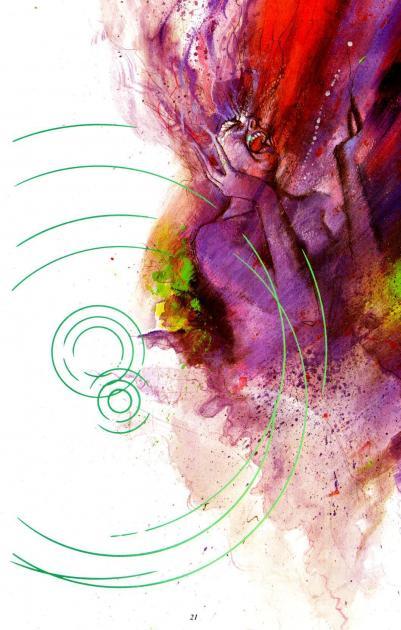8 examples of exceptional art in comics: Part 1
Comics are a wonderful literary medium; in their pages we find some of the most heroic characters, fantastically enticing stories, and remarkably cerebral plotlines. They possess the funniest of dialogues, and detail the most tragic of misfortunes. They give us all of the wonders that we find in the greatest of novels, but also something more. The true draw of a comic isn’t simply its masterful writing—it’s the combination of an excellent script and beautiful illustration. It is the artwork that truly sets the comic apart.
With that in mind I have decided to showcase some examples of the most fantastic art featured in modern comic books.
Now, in an effort to avoid already well-traveled ground, I have chosen to focus solely on less conventional examples of illustration. The entries on this list serve to represent the amazing diversity that has arisen in the form, and exhibit just how far the medium has come in the many decades since its inception. Entrants are thus graded as heavily on originality as execution.
This is not meant to detract from the more established styles of illustration, popular in the industry, or the artists who adopt them. I just seek to truly advertise how much the medium has evolved to encompass a wide variety of visual portrayal, not often enough attributed to the comic book.
Make no mistake though, these listings, as unique as they are, absolutely deserve any praise hefted upon them. They aren’t just examples of great comic art; they are examples of some of the best art, period.
This post will be presented in 2 parts, with each page featuring 4 comics of my choosing. So now, without further ado, here is the first part of my 8 examples of comics whose masterful illustrations would earn admiration from even the stingiest of art critics.
1. Secret War
Secret War was a Marvel Comics 5-part mini-series released between the years 2004 and 2005. It was written by Brian Michael Bendis to further reveal the aftermath of the Avengers Disassembled event (also written by Bendis.) The books featured a large number of memorable Marvel characters, including both heroes and villains. Though the execution of the plot did not receive universal praise, the series helped pave the way for many successful future Bendis stories in the same setting. However, the element that truly set these 5 books apart from the rest of Marvel’s offerings was not the writing, but undoubtedly the amazing painted illustrations of Gabriele Del’Otto.
Though perhaps not the most well-known of comic artists—at the time of Secret War’s publication or even now—the excellence of Del’Otto’s work cannot be overstated. The beautiful pages that fill this series are just absolutely astonishing. His paintings succeed in casting the often over-fanciful, superhero-ridden world of Marvel Comics in an entirely new light. The regular bright and fantastic setting is replaced with a dark, grimy sci-fi dystopia; a world of shady government organisations and abnormal technologically equipped terrorists. The action is conveyed with hand-painted emotion and a genuine sense of strife. When I flipped through these comics for the first time I couldn’t help but be reminded of the great work of Syd Mead. The cool blues of the backdrops and shadows, highlighted by bursts of saturated orange and green, served to bring back visions of early Blade Runner art concepts.
This is a book that truly advertises the artistic grandeur that the comics industry can provide.
Page Examples: http://imgur.com/a/bozAa
2. Black Orchid
Black Orchid is an often overlooked graphic novel written by celebrated fiction writer, Neil Gaiman. The comic was first published in 1988 by DC comics, and featured a new character who borrowed the likeness of an even more obscure DC property from the 70’s. Though new and unknown itself, Black Orchid brought in many familiar characters from the mainstream DC lines. The comic presented itself as a new perspective into the DC universe; it was a view from the shadows of the overtly fantastical world of comic superheroes—as seen by a complete foreigner.
The book succeeds in delivering everything we’ve come to expect from Mr. Gaiman. The story is all at once wonderfully dark, fantastic, and tragic. We are treated to new sides of characters we thought we knew, and given the chance to really connect with the hardships of the unfamiliar protagonist. This book is worth grabbing for the story alone, but rest assured this is not all it has to offer.
Black Orchid’s true draw, for me, was its absolutely unique visuals. The whole comic is just riddled with pages and panels that throw all notions of convention out the window—and it totally works. The book features some of the most beautiful, raw, and abstract art to come out of the Vertigo line—an imprint not itself unfamiliar with unorthodox comic art.
These pages are home to the gorgeous watercolour works of Dave McKean; a man well known for his cover work on the Hellblazer and Sandman titles. McKean manages to convey the veritable medley of tones within the story with astounding proficiency. This isn’t illustration meant to show you what the characters are going through—it makes you feel it. The palette reflects the emotion of the story, as does the layout. Some pages we are given a grimy noir-esque scene of blacks and sepias; others feature full washes of purples and greens, floating over the page without a panel in sight. This is a book that does not bound itself in tradition; it uses whatever means necessary to convey its point to the reader—this is true art, and it deserves far more acclaim.
Page Examples: http://imgur.com/a/xCpS0
3. Viking
Viking is a relatively new series that was published bi-monthly by Image Comics between April of 2009 and January of 2010. The short-lived comic was an entirely creator-owned title by Ivan Brandon, of Secret Invasion fame. Brandon created Viking as a more historically accurate take on the fabled Norsemen of legend, and the book goes to commendable lengths in keeping the content grounded to reality. The world and characters feel truly authentic—which, considering the subject matter, makes Viking a genuinely interesting read.
The story delivers a familiar crime mystery, but in a more unique setting, and the players of this story-world are everything their reputable namesake promises. Viking is a bloody, violent tale filled with all the plundering and pillaging you could hope for. Brandon does not fail in conveying his passion for the series or his love for the subject matter. The writing is generally well done, and though it stumbles here and there, I really enjoyed this book and its archetypal characters.
Of course the really interesting aspect of Viking—and the reason for its placement on this list—is its completely original approach to illustration. All visual aspects of this comic were the sole responsibility of one Nic Klein; a freelance professional whose work can be found all over the industry. Klein’s approach to this book is no less passionate than Brandon’s, and this really shows through in the final product. The work is profoundly emotive in nature, almost to a chaotic point. The art has no interest in stability or consistency; most pages don’t even keep the same style from start to finish. Klein really is just all over the place with this one; he presents some panels in a traditionally rendered fashion, while others carry a more “unfinished” feeling. Some pages are discernibly graphic, and still others could best be described as painterly. His designs go from tight to almost gestural; from rendered to sketchy. It’s entirely dissonant, but amazingly, and as a testament to Klein’s professionalism, it all works perfectly. What should be unfocused comes across as brilliant—you never find yourself lost amongst the myriad of styles, and nothing feels truly out of place. This is perhaps Klein’s greatest achievement with Viking, and one of the many reasons it deserves to be read.
Page Examples: http://imgur.com/a/upvDJ
4. Elektra & Wolverine: The Redeemer
Elektra & Wolverine: The Redeemer was a 3 part mini-series team-up between two of Marvel’s most renowned assassins. It was first published in 2002 and was the much anticipated product of collaboration between two legendary creators, comic writer Greg Rucka, and Japanese painter Yoshitaka Amano. The story takes place during a very early time in Wolverine’s superhero career—roughly right after he receives his adamantium trademark—and is presented not in standard narrative, but instead is written simply in prose, supported by occasional illustration.
This book doesn’t take any route we are traditionally accustomed to. This is clearly evident in Rucka’s unique approach to the team-up. Redeemer is a story focusing on development and exploration, not on action movie tropes and over-the-top fight scenes. We are treated to an original look on two beloved characters, both with darkness in their pasts. This is a story of intrigue and emotion; where the line between good and bad, black and white, isn’t clearly defined—this book takes place in the grey.
Rucka is a name we can trust to deliver us a good story, but once again he is not the reason for this novel's mention—that honor is awarded to illustrator Yoshitaka Amano. Amano’s name is well known throughout the realms of geekdom. He is most often recognised for his seminal work on the popular Japanese role-playing game series, Final Fantasy; though he has successfully experimented in many other mediums, including manga and animation.
Yoshitaka Amano’s style can best be described as an amalgamation between Western comic art and Eastern woodblock printing. His wonderfully wispy watercolour illustrations work to support Rucka’s prose, not by directly illustrating the action, but instead by loosely portraying characters and scenes in a series of ethereal paintings. This is not a traditional comic book, and there is nothing conventional about its approach to comic art.
Though Amano’s illustration is certainly not for everyone, those who do appreciate his unique style will find this book is nothing short of absolutely dazzling. Never have I found a better example of how wonderfully diverse this medium can be. If you can find this comic, I recommend you give it a try—it’s worth it.
Page Examples: http://imgur.com/a/kKw8W
---
Well that’s it for part one; check back next week for the second part of my 8 examples of exceptional (and unconventional) art in comics.
Part 2: http://www.comicsthegathering.com/blogs/mike-busch/1779/8-examples-exceptional-art-comics-part-2







Comments
Simply its Works